2022届高三英语写作专项提升:名词的用法课件(32张)
文档属性
| 名称 | 2022届高三英语写作专项提升:名词的用法课件(32张) | 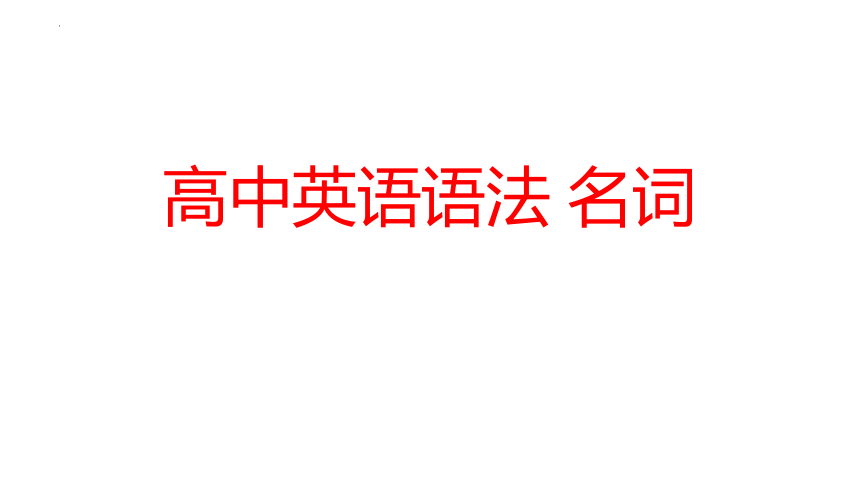 | |
| 格式 | pptx | ||
| 文件大小 | 273.8KB | ||
| 资源类型 | 教案 | ||
| 版本资源 | 通用版 | ||
| 科目 | 英语 | ||
| 更新时间 | 2022-06-05 20:35:22 | ||
图片预览


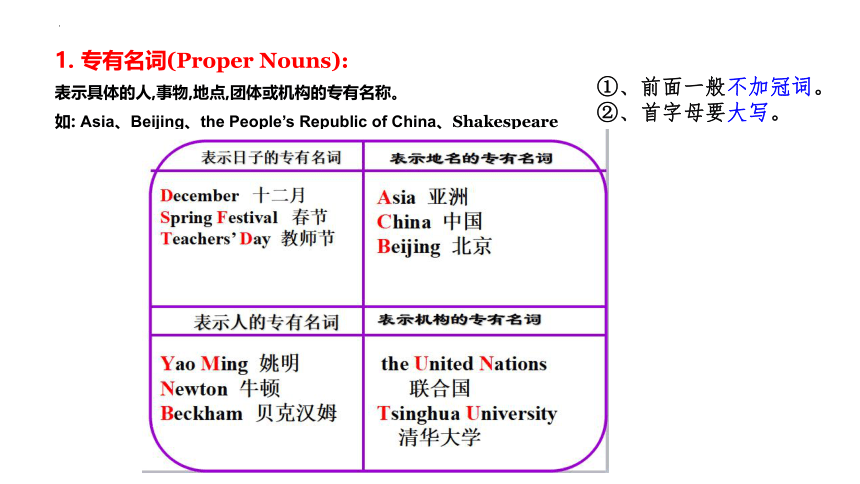
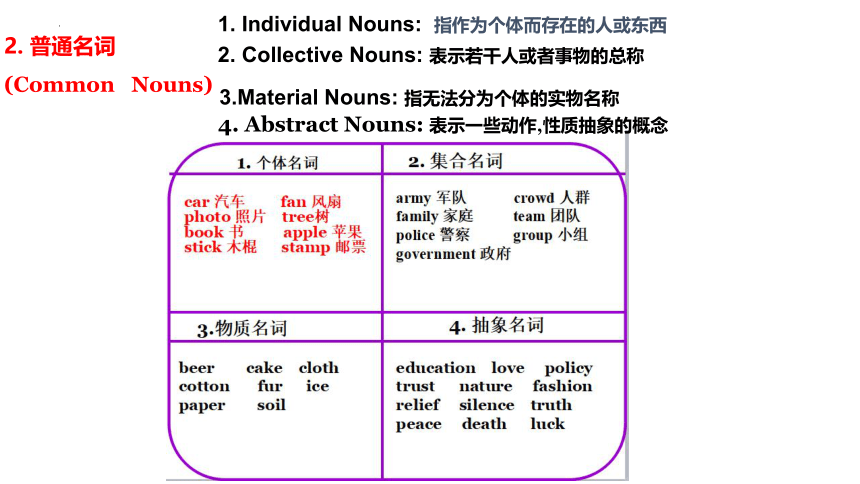

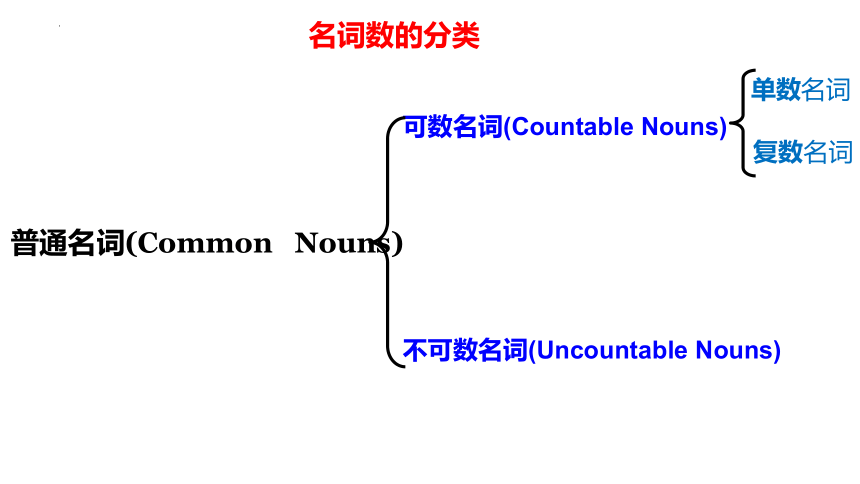
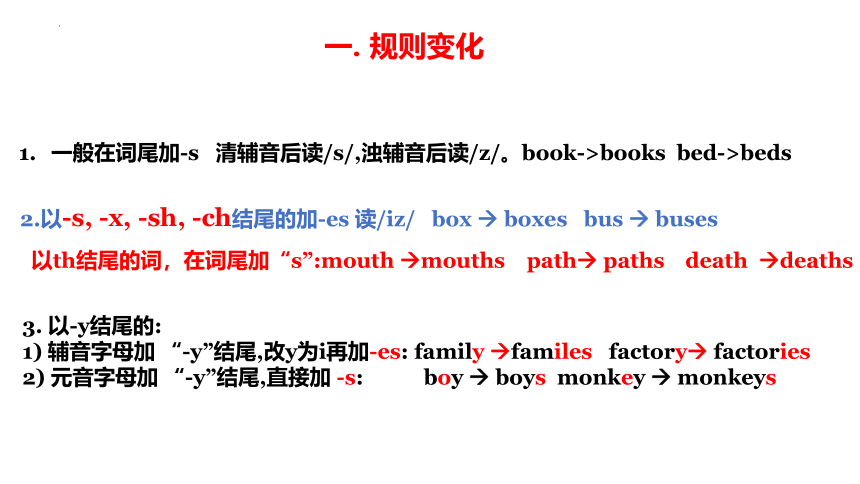
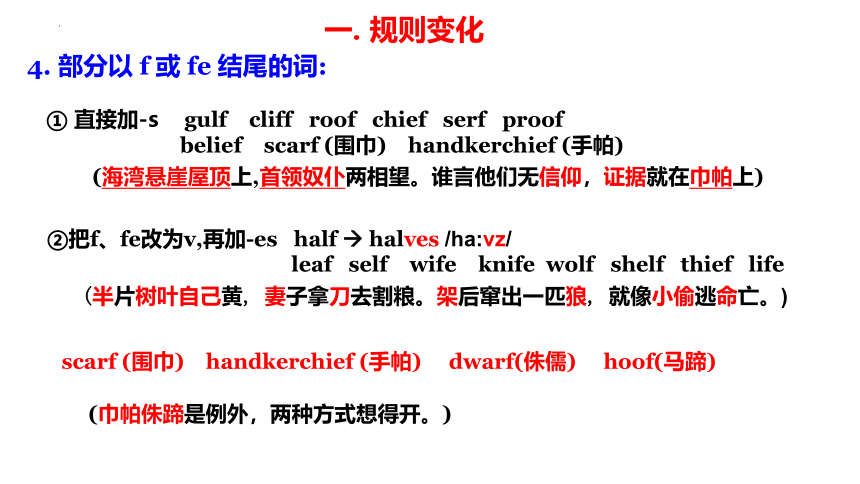

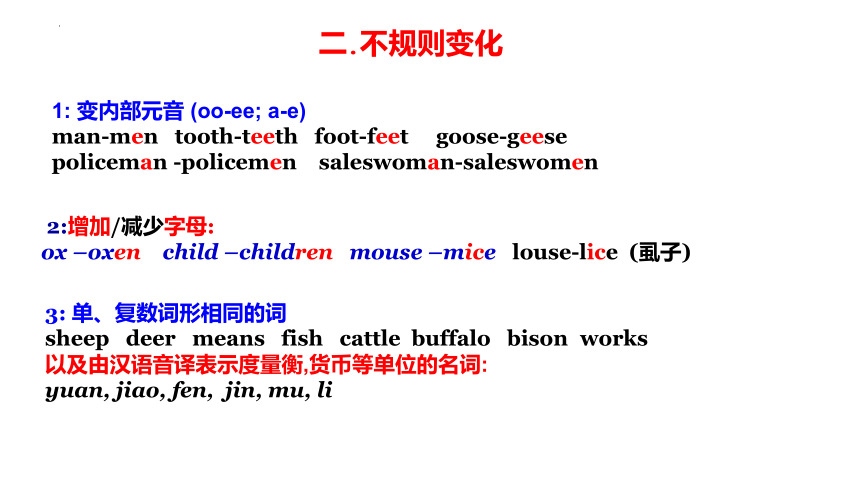
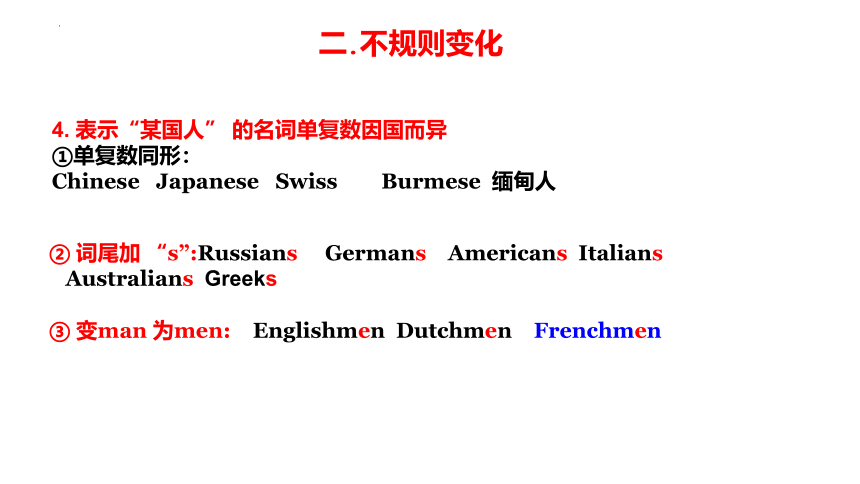

文档简介
(共32张PPT)
高中英语语法 名词
名词的那些事儿
一、名词的定义
二、名词的分类
三、名词的数
四、名词的格
五、名词的性
1. 专有名词(Proper Nouns):
表示具体的人,事物,地点,团体或机构的专有名称。
如: Asia、Beijing、the People’s Republic of China、Shakespeare
①、前面一般不加冠词。
②、首字母要大写。
1. Individual Nouns: 指作为个体而存在的人或东西
2. Collective Nouns: 表示若干人或者事物的总称
3.Material Nouns: 指无法分为个体的实物名称
4. Abstract Nouns: 表示一些动作,性质抽象的概念
2. 普通名词
(Common Nouns)
一、名词定义
用来表示人,事物,地名,现象或抽象概念的词
1.专有名词(Proper Nouns)
二、名词分类
2. 普通名词
(Common Nouns)
个体名词(Individual Nouns)
集体名词(Collective Nouns)
物质名词(Material Nouns)
抽象名词(Abstract Nouns)
不可数名词(Uncountable Nouns)
可数名词(Countable
Nouns)
小 结
名词数的分类
普通名词(Common Nouns)
可数名词(Countable Nouns)
不可数名词(Uncountable Nouns)
单数名词
复数名词
一. 规则变化
一般在词尾加-s 清辅音后读/s/,浊辅音后读/z/。book->books bed->beds
2.以-s, -x, -sh, -ch结尾的加-es 读/iz/ box boxes bus buses
3. 以-y结尾的:
1) 辅音字母加 “-y”结尾,改y为i再加-es: family familes factory factories
2) 元音字母加 “-y”结尾,直接加 -s: boy boys monkey monkeys
以th结尾的词,在词尾加“s”:mouth mouths path paths death deaths
4. 部分以 f 或 fe 结尾的词:
① 直接加-s gulf cliff roof chief serf proof
belief scarf (围巾) handkerchief (手帕)
(海湾悬崖屋顶上,首领奴仆两相望。谁言他们无信仰,证据就在巾帕上)
②把f、fe改为v,再加-es half halves /ha:vz/
leaf self wife knife wolf shelf thief life
(半片树叶自己黄, 妻子拿刀去割粮。架后窜出一匹狼, 就像小偷逃命亡。)
scarf (围巾) handkerchief (手帕) dwarf(侏儒) hoof(马蹄)
(巾帕侏蹄是例外,两种方式想得开。)
一. 规则变化
5.以o结尾的词
①:加 “s” , 读/z/ photo, radio, piano, zoo studio, bamboo,
tobacco, kangaroo,kilo, solo, memo(备忘录)
②:加-es 读/z/
tomato, potato, hero, Negro, echo mosquito
(黑人英雄吃柿豆, 蚊子回声来凑凑。)
以o结尾的例外词加“s”和“es”均可以:
zero (零蛋) volcano (火山) manifesto (宣言)
( 零蛋火山和宣言,两种形式均存在。)
一. 规则变化
二.不规则变化
1: 变内部元音 (oo-ee; a-e)
man-men tooth-teeth foot-feet goose-geese
policeman -policemen saleswoman-saleswomen
2:增加/减少字母:
ox –oxen child –children mouse –mice louse-lice (虱子)
3: 单、复数词形相同的词
sheep deer means fish cattle buffalo bison works
以及由汉语音译表示度量衡,货币等单位的名词:
yuan, jiao, fen, jin, mu, li
二.不规则变化
4. 表示“某国人” 的名词单复数因国而异
①单复数同形:
Chinese Japanese Swiss Burmese 缅甸人
② 词尾加 “s”:Russians Germans Americans Italians
Australians Greeks
③ 变man 为men: Englishmen Dutchmen Frenchmen
二.不规则变化
5.复合名词的复数形式:
①将合成名词中的主体名词变为复数:
looker (s)-on passer (s)-by new-comer (s)
mother (s)-in-law a grand-child six grand-children
②无主体名词将最后一部分变为复数:
grown-up(s) 成年人 go-between(s) 中间人 sit-in(s) 静坐抗议 good-for-nothing(s) 无用之人 forget-me-not(s) 勿忘我草
③含boy, girl, lady等的合成的名词,它们始终为单数,其后的名词则用复数形式。
a boy student two boy students a girl friend three girl friends
a lady driver four lady drivers
④含man或 woman的合成名词:它们随其后名词单复数的变化而变化
a man doctor two men doctors
a woman teacher four women teachers
man-servant gentleman-farmer
二.不规则变化
6. 外来词的不规则复数形式
basis-bases thesis-theses crisis-crises medium-media
phenomenon- phenomena
7. 字母、数字、符号的复数是加 ’s, 如: T’s 、 8’s 、 +’s
1.There are two e’s in this word.这个单词中有两个e.
2.His 7’s look like 1’s. 他写的7看起来像1.
8. 缩略词和拼缀词
VIP VIPs POW POWs 战俘
memo memos 备忘录P. PP (pages)L. LL. (lines)
9.以s结尾但不表示复数: (形似复数,实为单数)
mathematics, physics,politics, statistics, economics
news, the United States woods(森林), works(工厂)
1.表种类、数量,变复数
sand(沙子) –sands (沙滩) fuel (燃料)–fuels (各种燃料)
water (水) –waters (水域) wood (木材) –woods (森林)
ash (灰)–ashes (骨灰,遗骸) paper (纸张) –papers(论文)
green (绿色)–greens(青菜)
2. 不可数名词加不定冠词,变成可数
success (成功) –a success (成功的事) pleasure(高兴)–a pleasure (高兴的事)
experience (经验) –an experience (经历) relation (关系) –a relation (亲戚)
joy (喜悦)–a joy (使人喜悦的事) difficulty (困难) –a difficulty(困难的事)
surprise (惊奇)- a Surprise(惊奇的事)
单复数名词之间转换的情况
3.名词只能用复数形式的短语
do exercises 做操 take notes 做笔记 take turns 轮流 in rags 衣衫褴褛
in dozens 成打的 make repairs 搞修理 change trains 改换火车 make friends with 交朋友 shake hands with 握手 as follows 如下
4.名词单复数形式意义相同的短语:
①: make faces = make a face 做鬼脸
②: have talks with sb =have a talk with sb.与某人交谈
③: play jokes on=play a joke on 拿…开玩笑
④: make contributions to =make a contribution to 为…做贡献
三、不可数名的计量方式可
1. 巧妙区别可数名词和不可数名词
2.不可数名词的计量方式(常用量词)
1)物体分几半,名字不改变,不可数记心间:
(paper, milk, water, meat)
2)物体分几半,名字就改变可数名词记心间:
(car, radio, bed, man)
1.巧妙区分可数名词和不可数名词
1.以“容器”计量,常用于装在容器的物质
a cup of coffee 一杯咖啡 three bowls of water 三碗水
a bottle of ink一瓶墨水 two bags of rice 两袋大米
a tube of tooth-paste 一管牙膏 a box of biscuit 一盒饼干
2. 以“与物体形状有关的名词”计量, 常用于固体物质
a loaf/piece of bread 一块面包 a slice/piece of cake 一块蛋糕
a grain of rice 一粒米 a lump/piece of coal 一块煤
a lump of sugar 一块糖 a bar of chocolate 一块巧克力
2. 不可数名词的计量方式
3.以“重量单位”计量
a ton of water 一吨水 two kilos of rice 两公斤大米
three pounds of milk 三磅牛奶
4.用“piece/item”计量,常用于与媒介物, 宣传工具等有关的内容。
a piece/an item of news 一条新闻 a piece of advice 一条意见
a piece/an item of information 一份情报
a piece of work 一件工作
5.用“有关表方式的名词”计量,常用于表示行为,动作的名词。
a burst of applause 一阵掌声 a fit of anger 一股怒气
a flash of hope 一线希望 a peal/peals of laughter 一阵笑声
四、英语表示“大量;许多”归类
★ 修饰可数名词
★ 修饰不可数名词
★ 修饰两者的名词
① a good/great many +可+复 (大量的) quite a few (大量)
There are a great many books in the library.
②a large/great/good number of +可+复
There are a large/great/good number of students here.
③scores of +可+复 (几十个) dozens of +可+复 (几十个)
There were scores of boxes, all waiting to be checked and loaded.
I’ve been there dozens of times.
修饰可数名词的词组
修饰不可数名词的词组
①a large amount of+不可 +单数
He has spent a large amount of money on his new house.
② a great deal of + 不可+单数
He has given me a great deal of help.
③ quite a little +不可+单 (许多)
④ a large sum of +不可+单 (许多)
a lot of, lots of, plenty of
谓语动词根据被修饰的名词决定单复数形式
There are a lot of / lots of people in that room.
There is a lot of / lots of rice in the bag.
修饰可数或不可数名词均可
五、名词的格 (Case)
A:通格 Common case:主格 (Subject case)
宾格 (Object case)
B: 属格Genitive 所有格Possessive case
表示为 ...的
名词所有格表示所有关系,意为“···的”
所有格有三种形式:
①: “在名词后面+s” : 是表示有生命的东西的所有格
Mary’s father (’s 属格)
②: “of 所有格形式” 是表示无生命的东西的所有格
the name of the book (of 属格)
③: of + n’s 结构
a picture of his sister’s
a poem of Burn’s 彭斯的一首诗
二 ’s 属格的形式
1: 单数名词和不以-s结尾的复数名词通常在词尾加 ’s, 如:
Tom’s friend children’s books
2. 以 –s 结尾的复数名词所有格在后面仅加 “ ’ ”如: Teachers’ Day
3. 以 -s 结尾的专有名词可加“ ’s”,或 “ ’”,读作/iz/或/z/
如: Engels’s works 或 Engels’ works
’s 属格使用的对象
2. 表示一些无生命东西的名称。
① 表示国家,地区,城市等地名
Beijing’s Summer Palace
②用在天体名称的名词
the earth’s surface
③表示时间名称的名词:
today's China Daily
④: 表示价格,重量,距离,长度
twenty miles’ journey
⑤:拟人化的名词
Fortune’s smile 命运的微笑
1. 用于有生命的,或视为有生命的东西的这一类词。
① 表示人,人名,职称等名词 Your Excellency’s brilliant idea 阁下高见
② 表示集体的名词the majority’s view 多说人的意见
③ 表示较高等的动物the giraffe’s neck 长颈鹿的颈
四. 属格应用需要注意的问题
1. 不以 s 结尾的复数名词的所有格, 仍按惯例加“ ’s ”
Children’ s Day
2. 复合名词的所有格直接加 “-s”her sister-in-law’s house
3.如果两个名词并列并且都加’s则表示分别有;只有’s一个则表示共有.
Lucy’s and Lily’s rooms
Lucy and Lily’s room
-合住
4. “of” 多用于无生命现象的名词, 也可用于有生命现象的名词;
名词所有格的几个注意点
1.在表示店铺或教堂的名字或某人的家时, 名词所有格的后面,常常不出现它所修饰的名词.
the barber’s (shop) 在理发店 my aunt’s ( home) 在姑妈家
go to the teachers’ at the doctor’s
Mr. Green’s to my uncle’s
2.表示“某人自己的”的属格:
用of one’s own 表示, 不可用of+反身代词。
3.所有格用to
key, answer, bridge, way visit, exit, entrance
N’s 属格 VS of 属格
1 表示类别
children’s books 儿童读物
( books of children ×)
a women’s college 女子学院
( college of women ×)
a bachelor’s degree 学士学位
( degree of bachelor ×)
2 表示同位关系 “the + N+of 属格”
the town of Qinzhen 秦镇
Qinzhen’s town
Qinzhen town
the state of California
the six of us
×
√
双重属格(Double Genitive):
a bone of a dog
a bone of a dog’s
a portrait of the painter’s
a portrait of the painter
名词的性 (Gender)
性(Gender)是一种语法特征,英语名词往往自身就可以表明,
在单词形式上没有性的特征和变化。
1.Masculine (阳性):
bachelor 光棍汉 monk 和尚
gentlemen 先生 actor 男演员
bridegroom 新郎 prince 王子
widower 鳏夫 hero 英雄
landlord 房东 king 国王
2. Feminine (阴性):
actress 女演员 waitress女侍者
princess 公主 lass少女
heroine女豪杰 goddess女神
landlady女房东 bride 新娘
countess女伯爵 nun 尼姑
3.Common Gender 通性: baby (婴儿) child(孩子)
4. Neuter Gender (中性): desk(桌子) pencil(铅笔)
高中英语语法 名词
名词的那些事儿
一、名词的定义
二、名词的分类
三、名词的数
四、名词的格
五、名词的性
1. 专有名词(Proper Nouns):
表示具体的人,事物,地点,团体或机构的专有名称。
如: Asia、Beijing、the People’s Republic of China、Shakespeare
①、前面一般不加冠词。
②、首字母要大写。
1. Individual Nouns: 指作为个体而存在的人或东西
2. Collective Nouns: 表示若干人或者事物的总称
3.Material Nouns: 指无法分为个体的实物名称
4. Abstract Nouns: 表示一些动作,性质抽象的概念
2. 普通名词
(Common Nouns)
一、名词定义
用来表示人,事物,地名,现象或抽象概念的词
1.专有名词(Proper Nouns)
二、名词分类
2. 普通名词
(Common Nouns)
个体名词(Individual Nouns)
集体名词(Collective Nouns)
物质名词(Material Nouns)
抽象名词(Abstract Nouns)
不可数名词(Uncountable Nouns)
可数名词(Countable
Nouns)
小 结
名词数的分类
普通名词(Common Nouns)
可数名词(Countable Nouns)
不可数名词(Uncountable Nouns)
单数名词
复数名词
一. 规则变化
一般在词尾加-s 清辅音后读/s/,浊辅音后读/z/。book->books bed->beds
2.以-s, -x, -sh, -ch结尾的加-es 读/iz/ box boxes bus buses
3. 以-y结尾的:
1) 辅音字母加 “-y”结尾,改y为i再加-es: family familes factory factories
2) 元音字母加 “-y”结尾,直接加 -s: boy boys monkey monkeys
以th结尾的词,在词尾加“s”:mouth mouths path paths death deaths
4. 部分以 f 或 fe 结尾的词:
① 直接加-s gulf cliff roof chief serf proof
belief scarf (围巾) handkerchief (手帕)
(海湾悬崖屋顶上,首领奴仆两相望。谁言他们无信仰,证据就在巾帕上)
②把f、fe改为v,再加-es half halves /ha:vz/
leaf self wife knife wolf shelf thief life
(半片树叶自己黄, 妻子拿刀去割粮。架后窜出一匹狼, 就像小偷逃命亡。)
scarf (围巾) handkerchief (手帕) dwarf(侏儒) hoof(马蹄)
(巾帕侏蹄是例外,两种方式想得开。)
一. 规则变化
5.以o结尾的词
①:加 “s” , 读/z/ photo, radio, piano, zoo studio, bamboo,
tobacco, kangaroo,kilo, solo, memo(备忘录)
②:加-es 读/z/
tomato, potato, hero, Negro, echo mosquito
(黑人英雄吃柿豆, 蚊子回声来凑凑。)
以o结尾的例外词加“s”和“es”均可以:
zero (零蛋) volcano (火山) manifesto (宣言)
( 零蛋火山和宣言,两种形式均存在。)
一. 规则变化
二.不规则变化
1: 变内部元音 (oo-ee; a-e)
man-men tooth-teeth foot-feet goose-geese
policeman -policemen saleswoman-saleswomen
2:增加/减少字母:
ox –oxen child –children mouse –mice louse-lice (虱子)
3: 单、复数词形相同的词
sheep deer means fish cattle buffalo bison works
以及由汉语音译表示度量衡,货币等单位的名词:
yuan, jiao, fen, jin, mu, li
二.不规则变化
4. 表示“某国人” 的名词单复数因国而异
①单复数同形:
Chinese Japanese Swiss Burmese 缅甸人
② 词尾加 “s”:Russians Germans Americans Italians
Australians Greeks
③ 变man 为men: Englishmen Dutchmen Frenchmen
二.不规则变化
5.复合名词的复数形式:
①将合成名词中的主体名词变为复数:
looker (s)-on passer (s)-by new-comer (s)
mother (s)-in-law a grand-child six grand-children
②无主体名词将最后一部分变为复数:
grown-up(s) 成年人 go-between(s) 中间人 sit-in(s) 静坐抗议 good-for-nothing(s) 无用之人 forget-me-not(s) 勿忘我草
③含boy, girl, lady等的合成的名词,它们始终为单数,其后的名词则用复数形式。
a boy student two boy students a girl friend three girl friends
a lady driver four lady drivers
④含man或 woman的合成名词:它们随其后名词单复数的变化而变化
a man doctor two men doctors
a woman teacher four women teachers
man-servant gentleman-farmer
二.不规则变化
6. 外来词的不规则复数形式
basis-bases thesis-theses crisis-crises medium-media
phenomenon- phenomena
7. 字母、数字、符号的复数是加 ’s, 如: T’s 、 8’s 、 +’s
1.There are two e’s in this word.这个单词中有两个e.
2.His 7’s look like 1’s. 他写的7看起来像1.
8. 缩略词和拼缀词
VIP VIPs POW POWs 战俘
memo memos 备忘录P. PP (pages)L. LL. (lines)
9.以s结尾但不表示复数: (形似复数,实为单数)
mathematics, physics,politics, statistics, economics
news, the United States woods(森林), works(工厂)
1.表种类、数量,变复数
sand(沙子) –sands (沙滩) fuel (燃料)–fuels (各种燃料)
water (水) –waters (水域) wood (木材) –woods (森林)
ash (灰)–ashes (骨灰,遗骸) paper (纸张) –papers(论文)
green (绿色)–greens(青菜)
2. 不可数名词加不定冠词,变成可数
success (成功) –a success (成功的事) pleasure(高兴)–a pleasure (高兴的事)
experience (经验) –an experience (经历) relation (关系) –a relation (亲戚)
joy (喜悦)–a joy (使人喜悦的事) difficulty (困难) –a difficulty(困难的事)
surprise (惊奇)- a Surprise(惊奇的事)
单复数名词之间转换的情况
3.名词只能用复数形式的短语
do exercises 做操 take notes 做笔记 take turns 轮流 in rags 衣衫褴褛
in dozens 成打的 make repairs 搞修理 change trains 改换火车 make friends with 交朋友 shake hands with 握手 as follows 如下
4.名词单复数形式意义相同的短语:
①: make faces = make a face 做鬼脸
②: have talks with sb =have a talk with sb.与某人交谈
③: play jokes on=play a joke on 拿…开玩笑
④: make contributions to =make a contribution to 为…做贡献
三、不可数名的计量方式可
1. 巧妙区别可数名词和不可数名词
2.不可数名词的计量方式(常用量词)
1)物体分几半,名字不改变,不可数记心间:
(paper, milk, water, meat)
2)物体分几半,名字就改变可数名词记心间:
(car, radio, bed, man)
1.巧妙区分可数名词和不可数名词
1.以“容器”计量,常用于装在容器的物质
a cup of coffee 一杯咖啡 three bowls of water 三碗水
a bottle of ink一瓶墨水 two bags of rice 两袋大米
a tube of tooth-paste 一管牙膏 a box of biscuit 一盒饼干
2. 以“与物体形状有关的名词”计量, 常用于固体物质
a loaf/piece of bread 一块面包 a slice/piece of cake 一块蛋糕
a grain of rice 一粒米 a lump/piece of coal 一块煤
a lump of sugar 一块糖 a bar of chocolate 一块巧克力
2. 不可数名词的计量方式
3.以“重量单位”计量
a ton of water 一吨水 two kilos of rice 两公斤大米
three pounds of milk 三磅牛奶
4.用“piece/item”计量,常用于与媒介物, 宣传工具等有关的内容。
a piece/an item of news 一条新闻 a piece of advice 一条意见
a piece/an item of information 一份情报
a piece of work 一件工作
5.用“有关表方式的名词”计量,常用于表示行为,动作的名词。
a burst of applause 一阵掌声 a fit of anger 一股怒气
a flash of hope 一线希望 a peal/peals of laughter 一阵笑声
四、英语表示“大量;许多”归类
★ 修饰可数名词
★ 修饰不可数名词
★ 修饰两者的名词
① a good/great many +可+复 (大量的) quite a few (大量)
There are a great many books in the library.
②a large/great/good number of +可+复
There are a large/great/good number of students here.
③scores of +可+复 (几十个) dozens of +可+复 (几十个)
There were scores of boxes, all waiting to be checked and loaded.
I’ve been there dozens of times.
修饰可数名词的词组
修饰不可数名词的词组
①a large amount of+不可 +单数
He has spent a large amount of money on his new house.
② a great deal of + 不可+单数
He has given me a great deal of help.
③ quite a little +不可+单 (许多)
④ a large sum of +不可+单 (许多)
a lot of, lots of, plenty of
谓语动词根据被修饰的名词决定单复数形式
There are a lot of / lots of people in that room.
There is a lot of / lots of rice in the bag.
修饰可数或不可数名词均可
五、名词的格 (Case)
A:通格 Common case:主格 (Subject case)
宾格 (Object case)
B: 属格Genitive 所有格Possessive case
表示为 ...的
名词所有格表示所有关系,意为“···的”
所有格有三种形式:
①: “在名词后面+s” : 是表示有生命的东西的所有格
Mary’s father (’s 属格)
②: “of 所有格形式” 是表示无生命的东西的所有格
the name of the book (of 属格)
③: of + n’s 结构
a picture of his sister’s
a poem of Burn’s 彭斯的一首诗
二 ’s 属格的形式
1: 单数名词和不以-s结尾的复数名词通常在词尾加 ’s, 如:
Tom’s friend children’s books
2. 以 –s 结尾的复数名词所有格在后面仅加 “ ’ ”如: Teachers’ Day
3. 以 -s 结尾的专有名词可加“ ’s”,或 “ ’”,读作/iz/或/z/
如: Engels’s works 或 Engels’ works
’s 属格使用的对象
2. 表示一些无生命东西的名称。
① 表示国家,地区,城市等地名
Beijing’s Summer Palace
②用在天体名称的名词
the earth’s surface
③表示时间名称的名词:
today's China Daily
④: 表示价格,重量,距离,长度
twenty miles’ journey
⑤:拟人化的名词
Fortune’s smile 命运的微笑
1. 用于有生命的,或视为有生命的东西的这一类词。
① 表示人,人名,职称等名词 Your Excellency’s brilliant idea 阁下高见
② 表示集体的名词the majority’s view 多说人的意见
③ 表示较高等的动物the giraffe’s neck 长颈鹿的颈
四. 属格应用需要注意的问题
1. 不以 s 结尾的复数名词的所有格, 仍按惯例加“ ’s ”
Children’ s Day
2. 复合名词的所有格直接加 “-s”her sister-in-law’s house
3.如果两个名词并列并且都加’s则表示分别有;只有’s一个则表示共有.
Lucy’s and Lily’s rooms
Lucy and Lily’s room
-合住
4. “of” 多用于无生命现象的名词, 也可用于有生命现象的名词;
名词所有格的几个注意点
1.在表示店铺或教堂的名字或某人的家时, 名词所有格的后面,常常不出现它所修饰的名词.
the barber’s (shop) 在理发店 my aunt’s ( home) 在姑妈家
go to the teachers’ at the doctor’s
Mr. Green’s to my uncle’s
2.表示“某人自己的”的属格:
用of one’s own 表示, 不可用of+反身代词。
3.所有格用to
key, answer, bridge, way visit, exit, entrance
N’s 属格 VS of 属格
1 表示类别
children’s books 儿童读物
( books of children ×)
a women’s college 女子学院
( college of women ×)
a bachelor’s degree 学士学位
( degree of bachelor ×)
2 表示同位关系 “the + N+of 属格”
the town of Qinzhen 秦镇
Qinzhen’s town
Qinzhen town
the state of California
the six of us
×
√
双重属格(Double Genitive):
a bone of a dog
a bone of a dog’s
a portrait of the painter’s
a portrait of the painter
名词的性 (Gender)
性(Gender)是一种语法特征,英语名词往往自身就可以表明,
在单词形式上没有性的特征和变化。
1.Masculine (阳性):
bachelor 光棍汉 monk 和尚
gentlemen 先生 actor 男演员
bridegroom 新郎 prince 王子
widower 鳏夫 hero 英雄
landlord 房东 king 国王
2. Feminine (阴性):
actress 女演员 waitress女侍者
princess 公主 lass少女
heroine女豪杰 goddess女神
landlady女房东 bride 新娘
countess女伯爵 nun 尼姑
3.Common Gender 通性: baby (婴儿) child(孩子)
4. Neuter Gender (中性): desk(桌子) pencil(铅笔)
